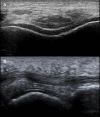Joint and tendon subclinical involvement suggestive of gouty arthritis in asymptomatic hyperuricemia: an ultrasound controlled study
- PMID: 21241475
- PMCID: PMC3241349
- DOI: 10.1186/ar3223
Joint and tendon subclinical involvement suggestive of gouty arthritis in asymptomatic hyperuricemia: an ultrasound controlled study
Abstract
Introduction: In this study, we aimed to investigate ultrasonographic (US) changes suggestive of gouty arthritis in the hyaline cartilage, joints and tendons from asymptomatic individuals with hyperuricemia.
Methods: We conducted a cross-sectional, controlled study including US examinations of the knees and first metatarsal-phalangeal joints (first MTPJs), as well as of the tendons and enthesis of the lower limbs. Differences were estimated by χ² or unpaired t-tests as appropriate. Associations were calculated using the Spearman's correlation coefficient rank test.
Results: Fifty asymptomatic individuals with hyperuricemia and 52 normouricemic subjects were included. Hyperechoic enhancement of the superficial margin of the hyaline cartilage (double contour sign) was found in 25% of the first MTPJs from hyperuricemic individuals, in contrast to none in the control group (P < 0.0001). Similar results were found on the femoral cartilage (17% versus 0; P < 0.0001). Patellar enthesopathy (12% versus 2.9%; P = 0.01) and tophi (6% versus 0; P = 0.01) as well as Achilles enthesopathy (15% versus 1.9%; P = 0.0007) were more frequent in hyperuricemic than in normouricemic individuals. Intra-articular tophi were found in eight hyperuricemic individuals but in none of the normouricemic subjects (P = 0.003).
Conclusions: These data demonstrate that morphostructural changes suggestive of gouty arthritis induced by chronic hyperuricemia frequently occur in both intra- and extra-articular structures of clinically asymptomatic individuals.
Figures
Comment in
-
Can ultrasonography make identification of asymptomatic hyperuricemic individuals at risk for developing gouty arthritis more crystal clear?Arthritis Res Ther. 2011 Apr 19;13(2):107. doi: 10.1186/ar3290. Arthritis Res Ther. 2011. PMID: 21542883 Free PMC article.
Similar articles
-
Can ultrasonography make identification of asymptomatic hyperuricemic individuals at risk for developing gouty arthritis more crystal clear?Arthritis Res Ther. 2011 Apr 19;13(2):107. doi: 10.1186/ar3290. Arthritis Res Ther. 2011. PMID: 21542883 Free PMC article.
-
Ultrasonographic Evaluation of Urate Crystal Deposition in Tendons With Gout Patients.Int J Rheum Dis. 2024 Dec;27(12):e70006. doi: 10.1111/1756-185X.70006. Int J Rheum Dis. 2024. PMID: 39676463
-
Articular cartilage of knee and first MTP joint are the preferred sites to find double contour sign as an evidence of urate crystal deposition in asymptomatic hyperuricemic individuals.Acta Reumatol Port. 2018 Oct-Dec;43(4):264-268. Acta Reumatol Port. 2018. PMID: 30641534 English.
-
Update of the current role of ultrasound in asymptomatic hyperuricemia. A systematic literature review.Joint Bone Spine. 2022 May;89(3):105335. doi: 10.1016/j.jbspin.2021.105335. Epub 2021 Dec 22. Joint Bone Spine. 2022. PMID: 34954078
-
Value and Progress of Ultrasound in Diagnosis and Treatment of Hyperuricemia.Zhongguo Yi Xue Ke Xue Yuan Xue Bao. 2017 Apr 20;39(2):280-284. doi: 10.3881/j.issn.1000-503X.2017.02.019. Zhongguo Yi Xue Ke Xue Yuan Xue Bao. 2017. PMID: 28483030 Review.
Cited by
-
Single nucleotide polymorphisms associated with P2X7R function regulate the onset of gouty arthritis.PLoS One. 2017 Aug 10;12(8):e0181685. doi: 10.1371/journal.pone.0181685. eCollection 2017. PLoS One. 2017. PMID: 28797095 Free PMC article.
-
Gouty arthritis: the diagnostic and therapeutic impact of dual-energy CT.Eur Radiol. 2016 Nov;26(11):3989-3999. doi: 10.1007/s00330-016-4237-2. Epub 2016 Feb 4. Eur Radiol. 2016. PMID: 26847043
-
Imaging of gout: an atlas.Rheumatol Adv Pract. 2025 Jun 4;9(2):rkaf051. doi: 10.1093/rap/rkaf051. eCollection 2025. Rheumatol Adv Pract. 2025. PMID: 40475075 Free PMC article. Review.
-
New classification criteria for gout: a framework for progress.Rheumatology (Oxford). 2013 Oct;52(10):1748-53. doi: 10.1093/rheumatology/ket154. Epub 2013 Apr 22. Rheumatology (Oxford). 2013. PMID: 23611919 Free PMC article. Review.
-
The JUMPFOOD study: additional effect of hydrolyzed collagen and vitamin C to exercise treatment for patellar tendinopathy (jumper's knee) in athletes-study protocol for a double-blind randomized controlled trial.Trials. 2023 Nov 28;24(1):768. doi: 10.1186/s13063-023-07783-2. Trials. 2023. PMID: 38017500 Free PMC article.
References
MeSH terms
LinkOut - more resources
Full Text Sources
Medical


